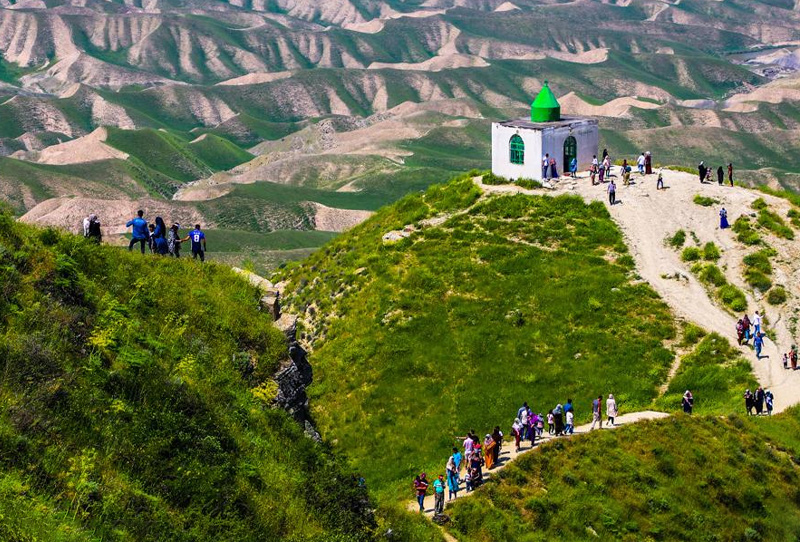Visiting a cemetery may seem scary to many people, and they may initially reject the idea. However, it’s good to know that not all cemeteries are the same, and some of them are not only not frightening but also attract a large number of visitors each year who buy tickets and pay to visit their attractions. Khaled Nabi Cemetery is considered one of the most interesting cemeteries in Iran. It is located in Golestan Province, in the city of Gonbad. It is famous for its shrine and its peculiar tombstones.
Although a significant portion of this cemetery has been destroyed or damaged by fire, many tourists still come to visit this area. The complex is situated in the mountains of Golestan Province and is the burial place of Khaled Nabi. Several large statues in this cemetery attract the attention of tourists. Additionally, the natural landscapes of this area add to its beauty.
Book Iran Air flights from London to Tehran and Tehran to London with Eligasht UK:
Geographical Location of Khaled Nabi Cemetery
Khaled Nabi Cemetery is located in a mountainous region, 62 kilometers northeast of Kalaleh County, 6 kilometers from Gachi Su Village, and 90 kilometers from Gonbad-e Kavus. It is situated on top of Mount Gogjeh Dagh, which is 720 meters high. The locals refer to this peak as “Qodrat” or “Tangari Dagh.” This mountain is surrounded by thousands of valleys to the north and west, the Baba Shamlak Mountains to the east in Maraveh Tappeh, and the Panj Shir Valley to the south. Due to the remote location of this area, access to Khaled Nabi Cemetery is more feasible from Kalaleh, Gonbad, and Maraveh Tappeh.
History of Khaled Nabi Cemetery:
Khaled Nabi Cemetery has a history of thousands of years and belongs to the Parthian period. It is considered a pilgrimage site in the northeast of Gonbad-e Kavus. Besides having graves with peculiar shapes, it contains several shrines, including the shrines of Khaled Nabi, Chupan Ata, and Alem Baba. Khaled ibn Sinan, known as Khaled Nabi among the Turkmen people, was a prophet who lived between the time of Jesus Christ (AS) and the Prophet of Islam (PBUH). During the reign of Anushiravan, when the people of Iran followed the Zoroastrian religion, Khaled Nabi came from Yemen to Iran to invite people to the religion of Ismail. Due to the respect and popularity Khaled Nabi had among the Turkmen people, there are several pilgrim inns, rooms, and a mosque for the rest and use of pilgrims around his shrine.
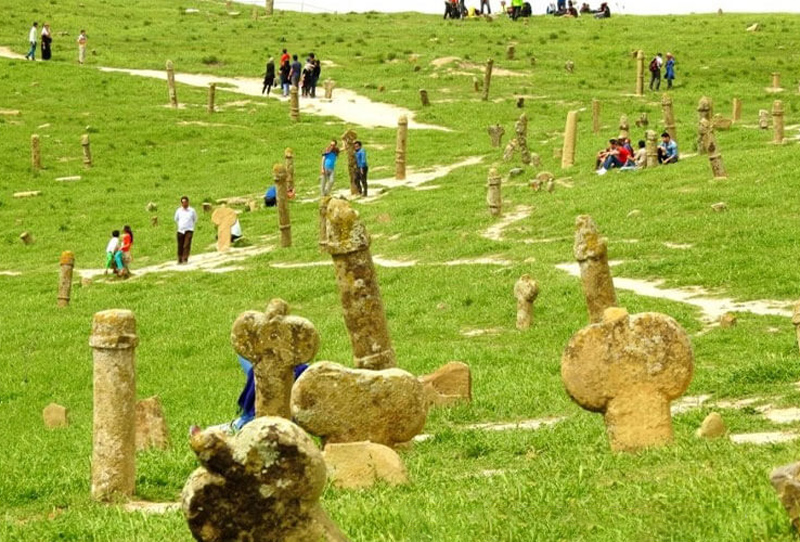
Khaled Nabi Graves
On the hills of the region and slightly beyond the Khaled Nabi shrine, several scattered statues with strange and peculiar shapes have been placed. According to historical documents, this cemetery dates back thousands of years, and it is said that at one point, there were around 600 of these stones. Some of these statues reach a height of 4 meters. Extensive studies have been conducted to determine the reason behind the peculiar shapes of these stones, and various theories exist. Some believe that the tall and elongated statues symbolize the male genitalia, and their height ranges from one to four meters depending on the social status of the grave owner.
The smaller statues also symbolize female genitalia and the breasts and breastbands of women. Others believe that the tall statues represent men wearing hats and belts around their waists, while the shorter statues represent branches and the head of a ram, symbolizing power. Some also believe that the statues resemble crosses. The common point is that these stone statues represent the grave markers of the inhabitants of the area.
It cannot be determined with certainty to which era these graveyards belong, but their long history is highly likely, and due to their placement on a hill and their inaccessibility, these cemeteries have remained relatively intact. However, in recent years, many of the stones have been broken, and approximately 3,000 hectares of this area were burned during a fire in Shahrivar 1396 (August-September 2017) within the vicinity of this cemetery. Although the cause of the fire was not determined, fortunately, it was contained by the locals and local authorities.
Related post
Discover the Historical Inscriptions in the Haft Tanan Museum Garden
Famous and Historical Churches of Isfahan
Local Beliefs about Khaled Nabi Cemetery
The Turkmen people hold interesting beliefs and superstitions about Khaled Nabi Cemetery. Some locals believe that the mountains surrounding the cemetery were once watermelons, but due to the curse of this area by Khaled Nabi, the watermelons turned into stones. Another belief is that a white cloth with colorful stripes is drawn over the grave of a newlywed who passes away.
This type of cloth is also found on the grave of Khaled Nabi, but it is unclear whether it is due to his premature death or simply as a sign of respect for him. Another local belief is that the peculiar statues represent the bodies of Khaled Nabi’s companions who, when hiding from enemies along with Khaled Nabi, were turned into stones by God so that they would not be captured by the enemies. Some also believe that these statues represent the bodies of Khaled Nabi’s enemies who were transformed into stones, but there is no evidence or documentation to support these claims.
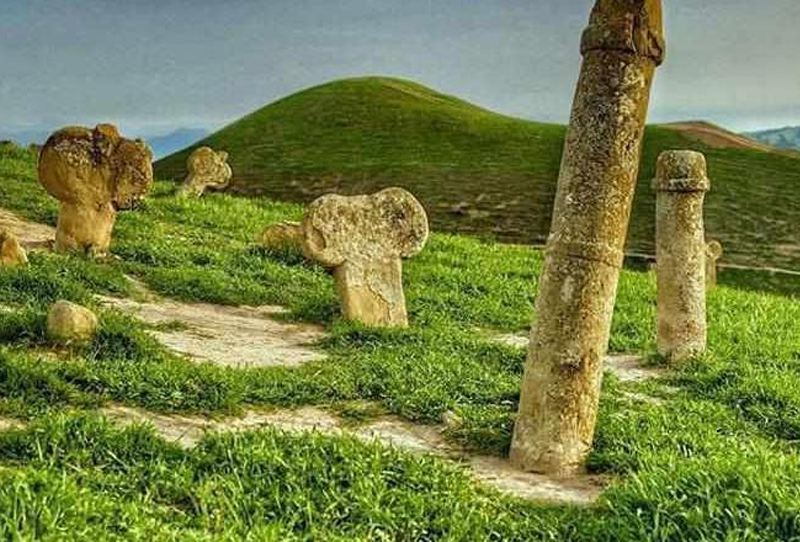
Attractions Around Khaled Nabi Cemetery
A spring has been located near the Khaled Nabi shrine, and its water flows during the spring season. It is very scenic and interesting, and according to the Turkmen people, the water of this spring has healing properties. Local people use this water to treat the illnesses of their cattle and sheep, and some visitors even take some of the spring water with them for healing and blessings. There is also a tree called “Nazarkardeh” in this mountainous area, which is located opposite the tomb of Allem Baba. Local people believe that this tree is magical and fulfills people’s wishes. For this reason, people tie their wishes to this tree. One of the reasons for the strength of these beliefs is the proximity of this tree to the mausoleum. People believe that this tree has not been coincidentally placed near the shrine, and it is under the spiritual influence of the mausoleum.
Best Time to Visit Khaled Nabi Cemetery
Choosing the right time to travel to Khaled Nabi Cemetery is very important. This area experiences hot summers and cold and rainy winters, and since the cemetery is located in a high and mountainous area, visiting it may not be easy and pleasant throughout the year. The best time to visit this place is during the months of Farvardin (March-April) and Ordibehesht (April-May). It is better to arrive early in the morning to avoid the heat of noon. Before heading to this cemetery, it is advisable to check the weather conditions, as apart from the stone graves, you won’t find any shelters.
Access to Khaled Nabi Cemetery
If you want to purchase a ticket to visit Khaled Nabi Cemetery, you should know that you need to travel to this cemetery by private car or bus. As mentioned, Khaled Nabi Cemetery is located in the village of Gachi Su in the suburbs of Kalaleh City, Golestan province. To reach this cemetery, you must take the Gorgan-Bojnurd route. After passing Azadshahr, you will reach Minoo City. However, you should not enter the city and continue your route. The next city on your way is Galikesh. After about 5 kilometers, you will reach Kalaleh, where you will take a left turn from the Bojnurd road and head towards Kalaleh.
Inside Kalaleh, take the signs for the Maraveh Tappeh route and continue on your way. Right from the start, you will notice the difference in the environment and the surrounding landscapes. This route will accompany you with the peculiar landscapes of the Turkmen desert, and along your way, you will see small and large wheat fields. After about half an hour, you will reach the village of Gachi Su. From this point onwards, your route to the village of Khaled Nabi will be on unpaved roads and then it will become asphalt again. Although the road conditions are relatively suitable, you can easily reach the vicinity of the hill. There is usually no traffic in this area, and you can easily park your car.
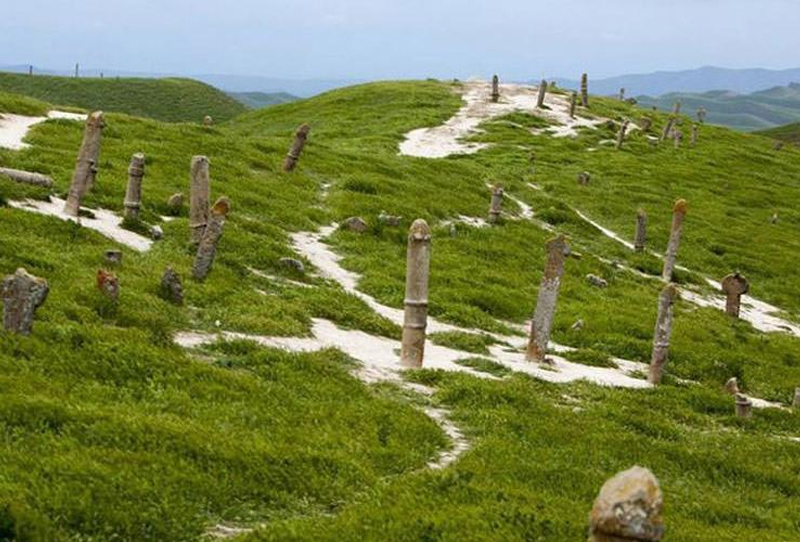
Recreational Facilities at Khaled Nabi Cemetery
Khaled Nabi Cemetery has become much busier than before, and most of the tourists and visitors are Turkmen. The parking situation in this area is not very convenient, and recently food and souvenir stalls have become active in this place. By visiting these stalls, you can buy various items such as Turkmen bags, hats, handmade rugs, and beautiful woven fabrics as souvenirs and enjoy them.
Near Khaled Nabi Cemetery, there are rental rooms available for overnight stays at a nominal cost. You can experience a pleasant night by combining the high altitude, strong wind, and the beauty of nature in this area, and spend the night peacefully in this place and enjoy being in nature.
Final words
Khaled Nabi Cemetery in Golestan province stands as a testament to the region’s rich history and cultural heritage. This sacred site, with its deep spiritual significance and tranquil surroundings, attracts visitors from near and far. The cemetery, along with the adjoining mausoleum and shrine, holds a special place in the hearts of both the local community and those seeking a connection to the past.
While the cemetery has become more popular in recent years, it is important to respect the sanctity of the place and its surroundings. Visitors are encouraged to follow the guidelines and regulations set forth to preserve the site’s integrity and ensure a peaceful experience for all.
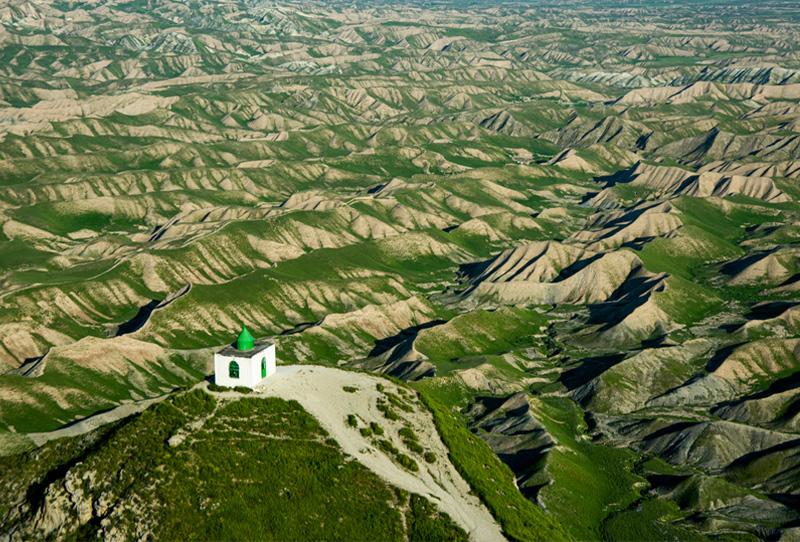
Frequently Asked Questions
1- Where is Khaled Nabi Cemetery?
Khaled Nabi is a complex consisting of Khaled Nabi Cemetery, Chupan Ata’s mausoleum, and Khaled Nabi shrine, located in the northwest of Golestan province.
2- Who is Khaled Nabi?
Khaled Nabi is the last preacher of the Christian faith, who was born 84 years before the birth of the Holy Prophet Muhammad.
3- When did the fire incident at Khaled Nabi occur?
This fire incident occurred on September 16, 2017, and it burned approximately three hectares of the area.
4- What is the best time to travel to Khaled Nabi?
The best time to visit and travel to this area is during the months of Farvardin (March-April) and Ordibehesht (April-May) in the spring season.
